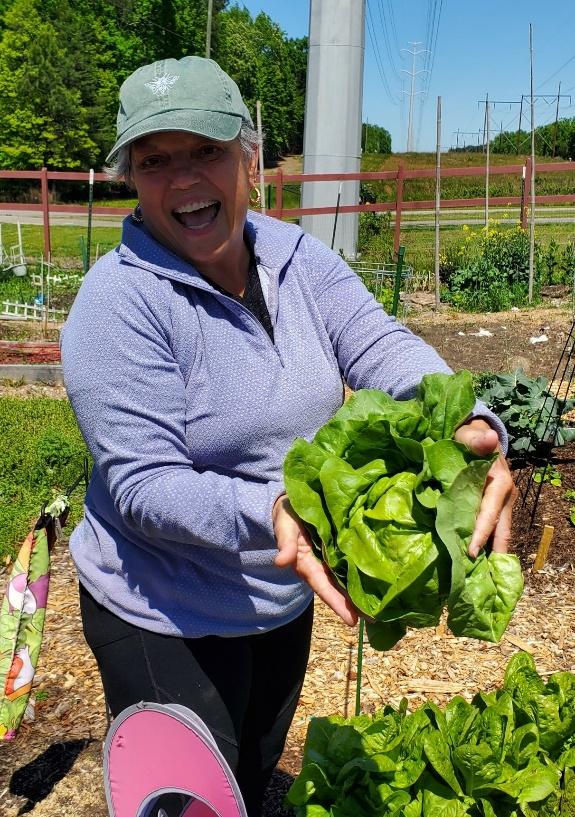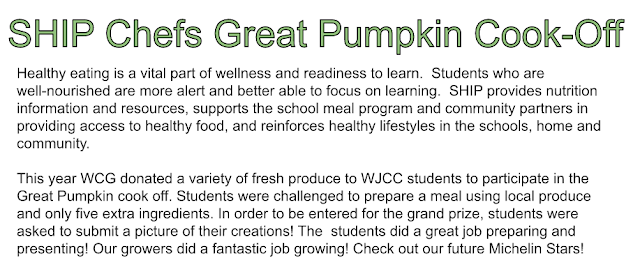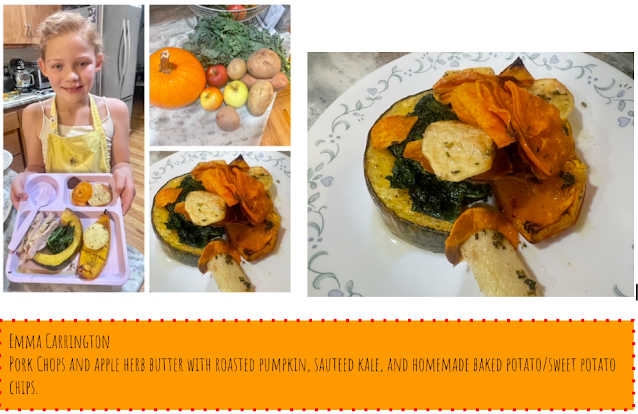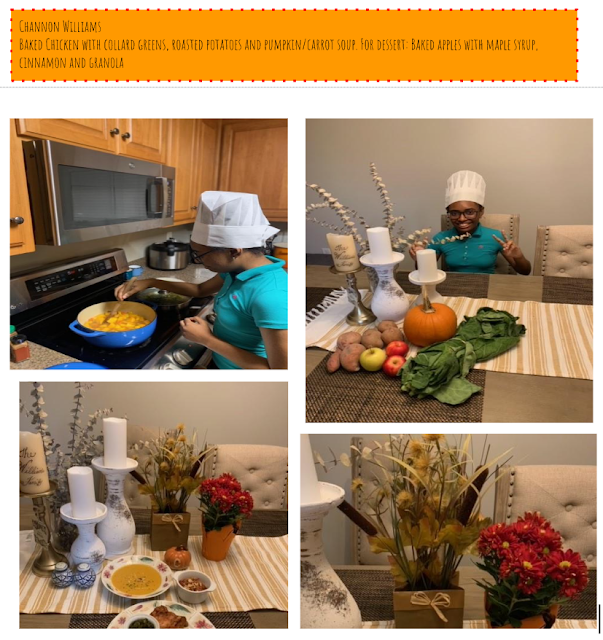Welcome new Farm Manager
How did your Garden grow this year
Save the date - Potluck, Seed Swap
Square foot gardening
Square foot gardening for kids
Garden Notes
Introducing our NEW Farm Manager
Sam Pereira

I am passionate about farming, agriculture and the sustainability it can bring to communities and the environment. I relocated to Williamsburg from Pennsylvania right before the pandemic and found it easy to settle into what I already knew, the medical field. I have been focusing on expanding my talents and finding ways to get involved in the community while sharing my passion and knowledge for what I truly enjoy.
Aside from spending my time outdoors in nature being active or with plants, I enjoy spending time with family and have a strong love for animals with one cat at home. I enjoy traveling and have a goal to visit every national park and so far I have quite a few checked off. I am very excited to be a part of Williamsburg Community Growers and look forward to what’s to come.
Editor’s note: Keep an eye out for Sam and welcome her to the garden!
How Did Your Garden Grow?
Wow! Did you all have a lot to share about your gardens this year! Below are most of the comments received broken up into good things, bad things, and advice to share. Enjoy!
Happy Times:
I ordered Radiator Charlie’s mortgage lifter seed from Park seed co. I could not pick them up quickly enough. Very large and productive tomato. (Editors note: we will add them to the list for the warm-season sale next year! And we all hate you! LOL)
Peppers and cucumbers did awesome!
Beans seemed to do really well planted next to the tomato plants.
Marigolds almost took over!
My neighbors were awesome!
The soil was good quality and rich.
My red and green bell peppers, jalapeno, sweet peppers did very well. Also, zucchini squash.
There were always friendly people around and water to use for the plants.
My lemon drop squash. Yellow, globe summer squash. Highly productive, great taste, easy to grow “up”.

My bell peppers were heroes. Planted 2, harvested 20+. Second place was my bush green beans.
My first summer at the garden. I enjoyed the experience and learned a lot of new things. I found people to be very helpful.
My tomatoes, both large and small, were delicious. I had a lot of cucumbers.
Our green beans were good, the grape tomatoes were great!
It was a great year for cantaloupes! And cherry tomatoes!
Transplanted 11 “volunteer” tomatoes into 2 rows in our 10 X 10 plot. They grew taller than us. The tomatoes were our heroes. Our biggest mistake was not to allow enough room to properly manage them.
Our most positive surprise was the number of neighbors who took us under their wing and gave us great pointers on what to do or not.
Monthly work sessions were a grand way to meet new gardeners and gain insights from them.
It has been a pleasure to experience such positive cooperation from the capable staff and genuine camaraderie with our fellow gardeners.
Our valiant heroes were cucumbers, radishes, summer squash, peppers, and various herbs. Tomatoes, though not prolific, were delicious.
Currently enjoying a lovely cool weather salad garden with beautiful crisp red leaf lettuce, spinach, parsley, radishes, beets, and a second crop of self-seeded dill.
Being now involved in the weekly delivery of produce to the Olde Towne medical facility has given us an unexpected but most welcome pride and sense of community.
Initial planting of squash and zucchini was awesome. Sweet potatoes, in less than a quarter of our small plot, produced 50-60 pounds!
The marigolds were unstoppable.
Being newbies this year, we were pleasantly surprised at how nice and helpful almost everyone we encountered was/is. We enjoyed watching everything grow and produce.
We had fabulous spring crops – lettuce, spinach, radishes, kale, more lettuce…It was great!
Lettuces were spectacular! Best crop we have ever had. All from the plant sale.


Sad Times:
Potato bugs ate my eggplants before they even had a real chance.
Melons grew well but creatures ate them before I could harvest them.
Tomatoes were dismal.
My tomatoes got caught by some cold nights in May and never fully recovered.
Lost all 12 of my tomatoes, assuming it was fusarium wilt.
Despite 2 attempts to grow eggplant, both attempts failed due to insect infestation.
Least favorite part was all the time spent weeding!
My zucchini was good but thought there would be more.
Would love information on how to prevent borers in our summer squash.
Relentless invasion of insistent weeds.
Eggplants (the bugs got ‘em), peas, winter squashes.
Tomatoes bombed; first eggplants were eaten by potato bugs. Second set did not grow much.
Second round of squash failed
Pumpkins just flat out failed.
The heat was certainly a challenge.
Biggest disappointment was the tomatoes, gorgeous until blight got them. Picked a few but not what we had anticipated.
Tomatoes got early blight and I wasn’t disciplined enough to keep after it with fungicide and stripping of diseased leaves.
Advice:
As everyone knows, the soil in our garden area soaks up water quickly. I sometimes wonder where it all goes. Later in the season, I began using coconut coir in addition to mulch. It gave me more water retention than I previously had.
If you like black eyed peas, try pink eye purple hull peas instead. Very similar in taste and extremely productive.
For tomatoes, before planting, put a couple spoons full of well ground eggshells
mixed in the soil.
More staggered plantings so the entirety of the crop doesn’t mature at the same time.(See article in newsletter of April 2021 about succession planting.)
To stagger planting as much as possible to extend harvests and alleviate too much coming all at once – it’s a long season.
Make more frequent, shorter visits rather than spending longer once per week in the Virginia heat.
Don’t plant too much. Make sure you can take care of what you plant. Seek out a buddy to water, harvest or even weed if you go away or are not able to check your plot at least every couple of days.
Keep your soil well-covered with some type of mulch to slow down the progression of weeds and to prevent the rain from splashing soil up on your plants, transmitting disease.
The best tomatoes in our garden were the Juliet (saladette size) and the grafted Purple Cherokee. Both are still producing.
Trench around your plot to slow the nasty weeds, like the Bermuda grass/wire grass, from getting into your nice soft soil.
Note from the Editor:
RE Eggplants – Eggplants are the preferred food source for flea beetles. They leave the tiny holes all over the leaves and suck the life out of poor baby transplants. To defeat the flea beetles, take a small piece of row cover (google it) and make a balloon to completely cover your entire plant. Secure it around the stalk of the plant with a twist tie. Leave the plant covered until it is large enough so the flea beetle damage doesn’t bother it (maybe a month?). This will also exclude the potato beetles. However, once the plant is uncovered, if potato beetles come back, just Squoosh them or knock them into a cup of soapy water. Watch for the juveniles as well which are slimy pinkish brain-like things. They Squoosh easily.
RE Tomatoes – The wilt diseases are in the soil in some parts of the garden and there is no way to rid ourselves of them except to let them die out over time. If you want tomatoes and have experienced wilt in your garden, consider planting your tomatoes in large (more than 5 gallons) pots on top of the soil or set somewhat into the soil. The blights can be battled by covering the soil, taking off the bottom leaves and any leaf that has even a single spot of disease, and applying an organic fungicide according to label instructions. Hard to stop it once it gets started, so prevention is the best. We will have a tomato class next spring to discuss this.
RE Borers in summer squash – Do not know a technique for excluding them. However, when you have a borer in the stalk (you can tell because the entire plant starts to wilt) you can cut into the stalk and kill the borer. Then, bury the stalk at that point and it is likely that the squash will send out new roots and go on from there.
SAVE THE DATES

End-of-Season Get Together – Fall is here and the Garden is winding down. The heat is gone and the days have been sunny and cool, after all the rain! How about meeting at the Garden on Saturday, October 22, 12-2, for a Potluck lunch with your Garden friends?
Everyone can bring a dish to pass, whatever you like, homemade or store-bought, with a serving utensil (please note any allergens in your dish such as peanuts, dairy, soy, gluten). We will supply plates, silverware, paper cups, and a drink.
Bring a lawn chair and a sun hat, if you wish and come chat with the people you often just see in passing. Fun, fun!

End of Season Seed Swap:
When: 1 November - 5, 2022 Sunrise to sunset
Where: WCG Shade Structure
A large plastic tote box, labeled “WCG Seed Swap” will be stored under the shade structure beginning 1 November and ending 5 November 2022.
Any unique varieties to share from this year? Any leftovers? Hand harvested seeds? How fun to share the joy with our garden friends! Flowers, vegetables, herbs. Special creative seed mixes.
Ground Rules: Non-invasive seeds ONLY!
A small pinch (1 tsp) for small seeds (example: tomatoes, calendula, zinnia, broccoli, carrots, etc.)
5 to 10 for large seeds (example: cucumber, sunflower seeds, beans, etc.)
Seeds should be in a small bag or envelope and labeled as follows:
The name and variety of the seed.
Who grew the seed and where.
The year the seed was produced.
Other useful information might involve growing tips and photos of the parent plants.
This swap is one for one, take one pack…leave one! Easy peasy!
What happens with the leftover seeds?
The container will be stored over the winter and returned when the garden re-opens in the spring planting!
Method to Consider Next Growing Season:
SQUARE FOOT GARDENING
What is it?!?!?!
Jim Thompson: Square Foot Gardener
One of our Community Gardeners, Jim Thompson, has set up a "square foot garden." This is a technique in which you divide a four-by-four raised bed into 16 squares. You then plant different crops in each square. Jim subscribes to the technique developed by Mel Bartholomew in the 1970's and now promoted by the Square-Foot Foundation. According to the foundation:
The Square Foot Gardening™ method saves gardeners time, effort, tools, space and water. Schools across the nation and international humanitarian groups around the world are using the Square Foot Gardening method making inroads against poverty and hunger. The Square Foot Gardening method is estimated to cost 50% less, uses 20% less space, 10% of the water, and only 2% of the work compared to single row gardening. Additional benefits are: virtually no weeds, no digging or rototilling, no fertilizers, and no heavy tools are necessary.
Visit Jim's plot to see how it works!

Square Foot Gardening with Kids

Have kids or grandkids around? Create your own square foot garden with paper towel seed Tape Grids! **Bonus math and composting lesson**
Supplies Needed:
Two-ply paper towels (did you know these measure exactly 1 square foot) Mind blowing!
Non toxic white glue or you can create your own glue with flour and water
Seeds of your Choice and planting guide
Step 1: Seperate Paper Towel and glue your seeds according to spacing requirement. While the glue is still wet, reapply the top layer of the paper towel to your seed mat. This step is not required as you can easily glue the seeds on top. Label your mat (don’t forget this step)
Step 2: Time to plant! The preferred method is to use raised beds, however, one of our growers has had success using this method in the ground. Be sure your soil is soft and nourished. See Barbara’s post on how to prepare your bed. Place the seed mat on well prepared soil and cover with compost or fresh soil. Water and ensure the seed mat stays moist until seeds germinate.
This method works great with fast growing radishes, crunchy kohlrabi, or snappy green beans! Seeds too small? Try this method with carrots, lettuce, and asian greens!
Allow children to create works of art by inter planting seeds. Vegetables aren’t the only way to use this method, flowers and herbs will also produce beautiful results that our pollinator friends will love!
Here are some helpful websites to get your creative gardening brains going:
https://www.youtube.com/watch?v=sZZJ1WWVZgI
Is this something you will try? Let us know!

Image obtained from: https://gardeninminutes.com/plant-spacing-chart-square-foot-gardening/
Garden Notes:
Reminder to let me know if you will not be returning to Garden with us next season, Barbara@growwilliamsburg.org
Garden insects frequently overwinter in debris on the soil. To get a leg up on insect control for next season, clean up all your leftover plant materials before winter.
We are looking for someone to help with the tasks of the Community Garden Coordinator. It is especially busy in the spring when plots need to be staked and prepared for new gardeners. Other tasks might be to help with new gardener orientations and work parties, contribute articles to the newsletter, or add to our face time in the Garden. Let me know if you might be interested. Barbara@growwilliamsburg.org
Watch the temperatures closely now for cold mornings. Remember that the micro-climate at the garden is harsher than elsewhere nearby because of almost constant wind. Harvest your tender plants or cover them when temperatures are low. If you want to take cuttings to overwinter, now is the time.








